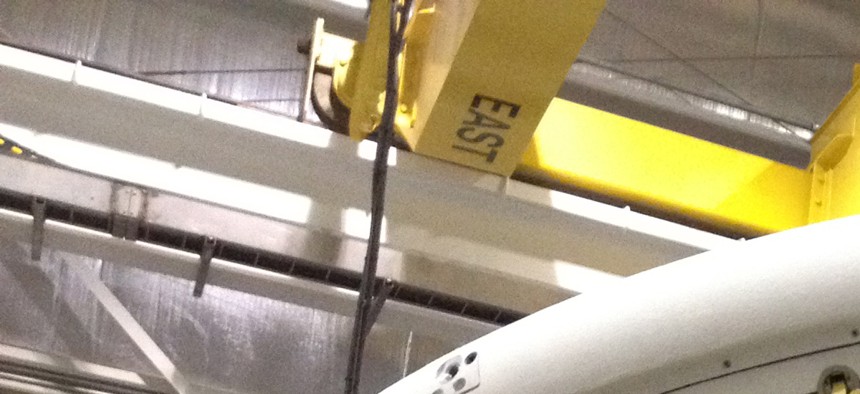NASA Is About to Test a Mega-Parachute at the Edge of Space

A saucer-shaped test vehicle holding equipment for landing large payloads on Mars in the Missile Assembly Building at the U.S Navy's Pacific Missile Range Facility at Kekaha on the island of Kaua‘i in Hawaii. NASA/AP
If the largest ever supersonic parachute works, we'll be a step closer to putting a human on Mars.
The key to a successful Mars landing is the same thing that matters in landing on any planet: You have to slow down before you hit the ground.
That's why scientists are testing a new supersonic parachute that they hope will advance the technology needed to land heavier-than-ever spacecrafts—like the kind that will eventually carry humans to the Red Planet. This week, NASA engineers are gathered at Hawaii's Pacific Missile Range Facility to launch their new Low-Density Supersonic Decelerator (LDSD), a complex package of devices including an inflatable flying saucer and a huge parachute designed for Mars landings. The name of the test vehicle is Keiki o ka honua , or "child from earth" in Hawaiian.
Parachutes have long helped devices touch down on Mars—dating back to the first successful robot landing in July 1976—but this parachute is much, much bigger than the ones that have been used in previous missions. At 110 feet in diameter, the Keiki o ka honua parachute is more than double the size of the one that carried the rover Curiosity down to the surface of Mars in August 2012.
To simulate the speed of spacecraft coming in for a landing in the super-thin atmosphere of Mars, scientists are testing the LDSD at an altitude of 180,000 feet—that's 34 miles away from the surface of the Earth, or about 10 miles farther than the place where stuntman Felix Baumgarter jumped to parachute from near-space down to Earth. "We have to go halfway to the edge of space," said Ian Clark, LDSD principal investigator, in a conference call with reporters on Monday.
LDSD will get two-thirds of the way to its mark in a balloon and the remainder of the way in a rocket. The balloon is big enough to "fit snugly into Pasadena's Rose Bowl," according to NASA . A fraction of a second after the saucer drops from the balloon at 120,000 feet, a rocket engine will shoot it another 60,000 feet toward outer space. Just getting the device to the point where the rocket takes over means overcoming any number of potential problems. "If we fire that motor and we get data back from it, that is a great day," said LDSD project manager Mark Adler.

If all goes as planned, once the LDSD gets to 180,000 feet, a Kevlar tube will inflate around the device—this tube helps create drag to slow it down as it falls, and collects data along the way. At maximum speed, the whole package will travel at four times the speed of sound, and heat up to near 600 degrees Fahrenheit, which is about the temperature a pizza would experience inside a brick oven. In order to withstand that kind of heat, the inflatable device is made from material "similar to the Kevlar we use to build bullet proof vests," Clark says. By the time the parachute opens, the device will have slowed down to Mach 2.5—or about 1,900 miles per hour and more than twice as fast as the speed of sound. It will still be another 45 minutes until the Keiki o ka honua touches down in the Pacific Ocean, where scientists will collect it.
The device will be outfitted with four GoPro cameras , plus several other cameras. A livestream of the launch will run on NASA's website. Weather conditions permitting, it could happen as early as tomorrow—Tuesday, June 3—beginning around 2 p.m. ET.
NASA plans to test two more saucer-shaped vehicles in Hawaii about a year from now.
NEXT STORY: Why Terrorists Love Twitter


